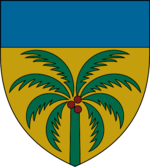Negasi: Difference between revisions
| Line 1: | Line 1: | ||
{{CountryInfobox | {{CountryInfobox | ||
| Nation name = Negasi Republic | | Nation name = Negasi Republic | ||
| Nation native name = Jamhuriyar Negasi ({{wp|Hausa language|Negasi}}) | | Nation native name = ''Jamhuriyar Negasi'' <small>({{wp|Hausa language|Negasi}})</small> | ||
| flag = Negasi flag.png | | flag = Negasi flag.png | ||
| coa = Negasi coa.png | | coa = Negasi coa.png | ||
| Line 52: | Line 52: | ||
===Colonial period=== | ===Colonial period=== | ||
[[File:1886 bas obispo.jpg|thumb|left|Building the [[Ubani Canal]]]] | [[File:1886 bas obispo.jpg|thumb|left|Building the [[Ubani Canal]]]] | ||
The | The region was colonized by [[Auresia]] in the late 7300s. | ||
During the colonial period, the [[Ubani Canal]] was built, beginning in 7563, It opened to ship traffic on December 15, 7574. | |||
===Post-colonial period=== | ===Post-colonial period=== | ||
Rising anti-colonialism globally following the [[Great Scourge]] after the turn of the 77th century led to a rise in Negali nationalism in the 7600s. The formation of the [[Open Seas Security Organization]] (OSSO), with its purpose of fostering maritime trade, after the [[First Coalition War]] (7632-7634) underscored the importance of the canal for shipping and as a national resource. On the eve of the [[Second Coalition War]], a general strike occurred across much of Negasi beginning on November 16, 7662. Among other effects, the strike shut down canal operations preventing transit between the Ovestian and Phasian Oceans. The strike led to Auresia granting Negasi its independence on January 30, 7663 in exchange for the restarting of canal operations and a promise to keep the canal open. | |||
==Geography== | ==Geography== | ||
While predominantly located in | While predominantly located in Tharna, Negasi is astride the division between Tharna and Tzeraka, with a portion of the country's southwest located in the latter continent. The Vovodaran Sea lies to the west and the Tanga Moji Sea adjoins Negasi's east coast. The Koradium Mountains lie along a significant portion of Negasi's northwestern border. This region is home to three large lakes: Moto, Jelwa, and Tila. The Giganum Mountains are in the south. The Ubani Narrows lies between the two large mountain ranges. | ||
The Oluwa Islands | The Oluwa Islands comprise a series of several islands off Negasi's west coast in the Vovodaran. There are several islands in the Tanga Moji, including Jabar, Set, Moriba, Salanko, M’basso, Torosso, Kolibelo, and Dyalinko islands. | ||
===Waterways=== | ===Waterways=== | ||
Revision as of 02:01, 27 September 2023
| Negasi Republic Jamhuriyar Negasi (Negasi) | |
| Flag | Coat of arms |
|---|---|

|

|
| Motto: | |
| Anthem: | |
| Locator map | |
| [[File:|300px]] | |
| Capital city | Bogaye |
| Largest city | Elmisi |
| Official language | Negasi |
| Other languages | |
| Ethnic group | |
| Religion | Naskel, Anur |
| Demonym(s) | Negasi |
| Government | |
| Government Type | Unitary parliamentary semi-presidential republic |
| Grand Chief | Rakanja Sadaka |
| Superintendent | Ayubu Owethu |
| Legislature | Superior Council |
| Establishment | |
| Area | |
| Total | 1,217,757.05 km2 |
| Water % | 4.39 |
| Population | |
| Total | 88,910,846 |
| Density | 73.01/km2 |
| Economy | |
| GDP (total) | Ꞡ 667.01 brillion |
| GDP per capita | Ꞡ 7,614.49 |
| Currency | Negasi nauyi () |
| Other information | |
| Driving side | right |
| Internet code | .neg |
Negasi, officially the Negasi Republic (Negasi: Jamhuriyar Negasi), is a country predominantly in southwest Tharna with a portion in northwest Tzeraka. Its western boundary is the Vovodaran Sea and the Tanga Moji Sea lies to the country's east. The Ubani Canal links these two seas, forming a route for ocean-going vessels between the Ovestan and Phasian Oceans. The country has an area of 1,217,757 km2 (470,179 sq mi) with a population of 88,910,846.
History
Early history
Colonial period
The region was colonized by Auresia in the late 7300s.
During the colonial period, the Ubani Canal was built, beginning in 7563, It opened to ship traffic on December 15, 7574.
Post-colonial period
Rising anti-colonialism globally following the Great Scourge after the turn of the 77th century led to a rise in Negali nationalism in the 7600s. The formation of the Open Seas Security Organization (OSSO), with its purpose of fostering maritime trade, after the First Coalition War (7632-7634) underscored the importance of the canal for shipping and as a national resource. On the eve of the Second Coalition War, a general strike occurred across much of Negasi beginning on November 16, 7662. Among other effects, the strike shut down canal operations preventing transit between the Ovestian and Phasian Oceans. The strike led to Auresia granting Negasi its independence on January 30, 7663 in exchange for the restarting of canal operations and a promise to keep the canal open.
Geography
While predominantly located in Tharna, Negasi is astride the division between Tharna and Tzeraka, with a portion of the country's southwest located in the latter continent. The Vovodaran Sea lies to the west and the Tanga Moji Sea adjoins Negasi's east coast. The Koradium Mountains lie along a significant portion of Negasi's northwestern border. This region is home to three large lakes: Moto, Jelwa, and Tila. The Giganum Mountains are in the south. The Ubani Narrows lies between the two large mountain ranges.
The Oluwa Islands comprise a series of several islands off Negasi's west coast in the Vovodaran. There are several islands in the Tanga Moji, including Jabar, Set, Moriba, Salanko, M’basso, Torosso, Kolibelo, and Dyalinko islands.
Waterways
- Babukar River
- Ubani Canal
- Some other significant rivers (prolly 11 or 12 of them)
Climate
Negasi has a tropical wet climate along its western coastal region which large humid tropical areas inland. A band of tropical savanna wraps round a region of hot semi-arid grasslands in the east. A small area of oceanic climate lies north of the Giganum Mountains in the south center of the country.